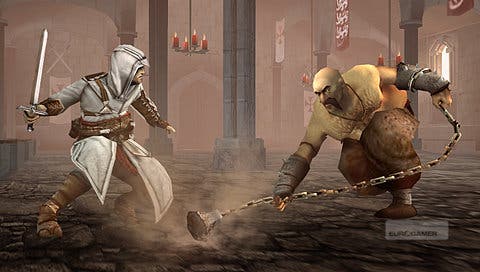Assassin's Creed: Bloodlines
Moving targets.
Should they decide to give chase, or should you be plunged into a fight by the mission design, you'll be alerted to this by a shift in music and an icon in the top-left, and you can either fight them off or leg it. Fighting involves either striking rhythmically with your sword - timing each button press to coincide with the previous blow hitting its target - or waiting for an enemy attack animation to begin and getting in there first with a counter, resulting in a knockout or a grisly instant-kill finishing move.
Leg it, however, and all you have to do is break line-of-sight from your pursuers and you can take advantage of one of many rooftop gardens (shacks with curtains) or haybales to restore your anonymity. When you're anonymous, you're best placed to employ your signature move: selecting and then plunging your hidden blade into a victim by going up to them and pressing the attack button.
The original Assassin's Creed was criticised for its repetitive and lacklustre missions, and Bloodlines tries to avoid this. Rather than being given a target and having to perform rote activities to reach an imaginary threshold that allows you to go off and be an assassin, a selection of different tasks is fed to you in linear fashion, some of which are assassinations, some of which are intelligence-gathering, and each of which typically consists of several phases.
For example, you kill a man in the city of Kyrenia - one of two major locations in the game - and the next mission is to break up the riots caused by your actions, which involves going to a particular place and getting in a fight, but then also taking down a group of archers on rooftops within a time limit because they're firing burning arrows at a church. The key assassinations themselves are often more like linear third-person action game levels, where you have to stealth or fight your way through a sequence of rooms and courtyards until you reach a boss, who needs to be fought to the death.

Elsewhere you can do side missions that are closer to those of the first game, like fighting Templars who are accosting random civilians in the street, or climbing up to viewpoints on towers. You can also collect Templar coins, scattered around the streets and rooftops, which you can invest in upgrades at intervals - things like more throwing knife inventory, more health, and so on.
So far then, a passable impression with some slightly different bits. Unfortunately though, despite adopting a slightly better approach than the original Assassin's Creed in some places, things fall down somewhat in the details. Those side missions, for example, are almost all pointless, while the collectables and upgrades are perfunctory.
One of the greater problems is the AI, and it's at this point you start to hope all those chickens aren't borrowing too much from the CPU, because whichever cycles they're using up, these guys could do with them. The NPC Templars and other guards are programmed to chase you down whenever you do anything fun, or especially if you start running by the pool, but that's not the problem - the problem is that they're stupid beyond explanation.








